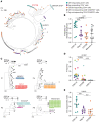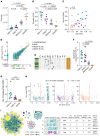Antigen-driven clonal selection shapes the persistence of HIV-1-infected CD4+ T cells in vivo
- PMID: 33301425
- PMCID: PMC7843227
- DOI: 10.1172/JCI145254
Antigen-driven clonal selection shapes the persistence of HIV-1-infected CD4+ T cells in vivo
Abstract
Clonal expansion of infected CD4+ T cells is a major mechanism of HIV-1 persistence and a barrier to achieving a cure. Potential causes are homeostatic proliferation, effects of HIV-1 integration, and interaction with antigens. Here, we show that it is possible to link antigen responsiveness, the full proviral sequence, the integration site, and the T cell receptor β-chain (TCRβ) sequence to examine the role of recurrent antigenic exposure in maintaining the HIV-1 reservoir. We isolated CMV- and Gag-responding CD4+ T cells from 10 treated individuals. Proviral populations in CMV-responding cells were dominated by large clones, including clones harboring replication-competent proviruses. TCRβ repertoires showed high clonality driven by converging adaptive responses. Although some proviruses were in genes linked to HIV-1 persistence (BACH2, STAT5B, MKL1), the proliferation of infected cells under antigenic stimulation occurred regardless of the site of integration. Paired TCRβ and integration site analysis showed that infection could occur early or late in the course of a clone's response to antigen and could generate infected cell populations too large to be explained solely by homeostatic proliferation. Together, these findings implicate antigen-driven clonal selection as a major factor in HIV-1 persistence, a finding that will be a difficult challenge to eradication efforts.
Keywords: AIDS/HIV; Adaptive immunity; Clonal selection; Immunology; T cells.
Conflict of interest statement
Figures






Similar articles
-
The forces driving clonal expansion of the HIV-1 latent reservoir.Virol J. 2020 Jan 7;17(1):4. doi: 10.1186/s12985-019-1276-8. Virol J. 2020. PMID: 31910871 Free PMC article. Review.
-
Expanded cellular clones carrying replication-competent HIV-1 persist, wax, and wane.Proc Natl Acad Sci U S A. 2018 Mar 13;115(11):E2575-E2584. doi: 10.1073/pnas.1720665115. Epub 2018 Feb 26. Proc Natl Acad Sci U S A. 2018. PMID: 29483265 Free PMC article.
-
HIV Subtype and Nef-Mediated Immune Evasion Function Correlate with Viral Reservoir Size in Early-Treated Individuals.J Virol. 2019 Mar 5;93(6):e01832-18. doi: 10.1128/JVI.01832-18. Print 2019 Mar 15. J Virol. 2019. PMID: 30602611 Free PMC article.
-
The role of integration and clonal expansion in HIV infection: live long and prosper.Retrovirology. 2018 Oct 23;15(1):71. doi: 10.1186/s12977-018-0448-8. Retrovirology. 2018. PMID: 30352600 Free PMC article. Review.
-
Early Emergence and Long-Term Persistence of HIV-Infected T-Cell Clones in Children.mBio. 2021 Apr 8;12(2):e00568-21. doi: 10.1128/mBio.00568-21. mBio. 2021. PMID: 33832973 Free PMC article.
Cited by
-
Understanding latent HIV-1 reservoirs through host genomics approaches.iScience. 2023 Oct 28;26(11):108342. doi: 10.1016/j.isci.2023.108342. eCollection 2023 Nov 17. iScience. 2023. PMID: 38026212 Free PMC article. Review.
-
Distinct gene expression by expanded clones of quiescent memory CD4+ T cells harboring intact latent HIV-1 proviruses.Cell Rep. 2022 Sep 6;40(10):111311. doi: 10.1016/j.celrep.2022.111311. Cell Rep. 2022. PMID: 36070690 Free PMC article.
-
Machine Learning Bolsters Evidence That D1, Nef, and Tat Influence HIV Reservoir Dynamics.Pathog Immun. 2024 Jan 23;8(2):37-58. doi: 10.20411/pai.v8i2.621. eCollection 2023. Pathog Immun. 2024. PMID: 38292079 Free PMC article.
-
Prolonged viral suppression with anti-HIV-1 antibody therapy.Nature. 2022 Jun;606(7913):368-374. doi: 10.1038/s41586-022-04597-1. Epub 2022 Apr 13. Nature. 2022. PMID: 35418681 Free PMC article.
-
Viral Persistence in the Gut-Associated Lymphoid Tissue and Barriers to HIV Cure.AIDS Res Hum Retroviruses. 2023 Dec 13;40(1):54-65. doi: 10.1089/AID.2022.0180. Online ahead of print. AIDS Res Hum Retroviruses. 2023. PMID: 37450338 Free PMC article.
References
Publication types
MeSH terms
Substances
Grants and funding
LinkOut - more resources
Full Text Sources
Other Literature Sources
Medical
Research Materials
Miscellaneous

